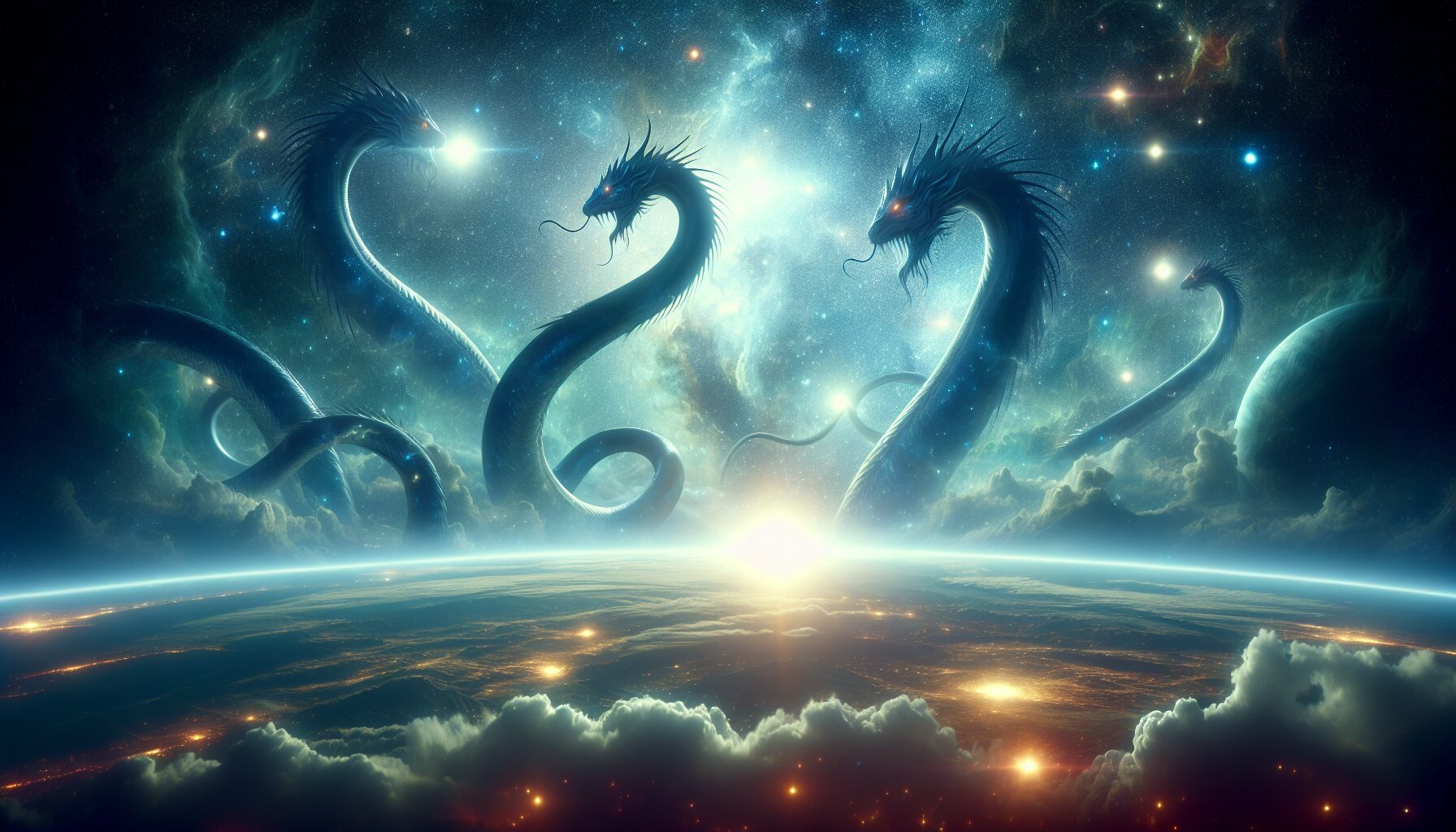The sky has always been a canvas for the stories and myths that humans create, and among these tales, the Star Serpents are particularly intriguing. These celestial creatures, woven into the mythologies of various cultures, stand as testimonies of humanity’s quest to understand the universe. From the swirling Milky Way to specific constellations that slither across the night sky, serpents have transcended their terrestrial origins to become cosmic icons.
Origins of Star Serpents in Mythology
Serpents hold a profound place in mythologies worldwide, representing both creation and destruction, wisdom and chaos. In the context of the skies, they often embody powerful stories:
- Norse Mythology: Jörmungandr, the Midgard Serpent, is among the most famous celestial serpents, feared for encircling the entirety of Earth, as described in The Prose Edda. This serpent’s cosmic role is detailed in sources such as The Prose Edda, where it is foretold that Jörmungandr will play a crucial role in Ragnarok, the end of the world.
- Chinese Mythology: In Chinese culture, the Dragon, which is often depicted as a serpent, is not just a symbol of wisdom but also of the celestial order. The Azure Dragon, known as Qinglong, is one of the Four Symbols of Chinese mythology, representing the East and springtime.
- Mesoamerican Mythology: The Feathered Serpent, known as Quetzalcoatl among the Aztecs and Kukulkan with the Maya, is a deity associated with the morning star, rebirth, and renewal. This serpent god is a vivid representation of the connection between the heavens and Earth, influencing both art and religious practices.
Constellations and Celestial Patterns
In the night sky, serpent-related imagery is abundant. Various cultures have identified celestial serpents among the stars:
“The constellation Ophiuchus represents a man holding a snake, symbolized by the neighboring constellation Serpens. This cosmic combat is believed to be symbolic of healing and eternal struggle.” — StarDate
- Draco: One of the most well-known serpent constellations, Draco represents the dragon killed by Hercules. This winding constellation which coils around the northern celestial pole is a source of intrigue and legend.
- Hydra: Known as the largest constellation, Hydra represents the water serpent. In ancient Greek mythology, when Heracles killed Hydra, it became a permanent fixture in the skies, immortalized among the stars.
- Serpens: This unique constellation is divided into two parts: Serpens Caput (Serpent’s Head) and Serpens Cauda (Serpent’s Tail), emphasizing its mystical and divided nature.
Astronomical Significance and Cultural Impact
While they offer a mythological perspective, celestial serpents also draw connections to astronomy and the understanding of our cosmos. The myths surrounding serpents often intertwine with real astronomical phenomena:
- The Milky Way: Often described as a celestial river, the sprawling band of stars has been seen as a serpent or dragon in various cultures, guiding wanderers with its luminescent trail.
- Comets and Meteors: These were sometimes interpreted as celestial serpents dashing across the sky, foretelling natural changes or omens to ancient civilizations.
Symbolism in Art and Literature
Artistic representations of serpents in the sky are widespread, from ancient petroglyphs to Renaissance paintings. These depictions are not mere works of art; they are interpretations of humanity’s imagination:
- Petroglyphs and Cave Paintings: Ancient civilizations often depicted serpentine figures in relation to the stars, as evidenced by sites across Europe and the Americas.
- Renaissance and Baroque Art: Artists of these eras utilized celestial serpents to depict stories from mythology, infused with religious and symbolic meaning, demonstrating the continued influence of these mythic creatures.
- Modern Literature and Media: Today, the serpent remains a potent symbol in sci-fi and fantasy literature, representing the unknown and the majesty of space, as explored in works like Frank Herbert’s Dune.
“The thing about science fiction is that it often places humanity against the backdrop of stars and celestial phenomena. Star serpents serve as metaphors for the challenges and mysteries we face.” — Frank Herbert
Persisting Mysteries and Future Discoveries
As we extend our gaze to newly discovered galaxies and nebulas, celestial serpents invite us to ponder their place in both ancient lore and modern understanding. Could these timeless creatures hold clues to forgotten wisdom or mysteries yet to unravel?
The myths of star serpents remind us that stories serve as bridges between our world and the cosmos, inspiring us to explore and decipher the universe’s secrets. These mythologies may provide metaphoric insights into our challenges, reminding us of the balance between creation and chaos that serpents signify.
Conclusion
Whether as mythical dragons looming over a medieval sky or as serpentine studies in the slick pages of a modern science fiction novel, the imagery of star serpents beckons us to look up and beyond. They embody the eternal human pursuit of the eternal — a journey through myth, culture, and cosmos that intertwines with the stars themselves.
Ultimately, the mythology of star serpents goes beyond mere narrative; it resonates with the profound and eternal curiosity of humans looking beyond the sky, linking stars with stories and ensuring that through every era, the serpents’ dance among the stars continues.

Comments